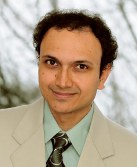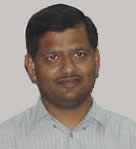Aerospace Engineering
Abhishek(U of Maryland, College Park)
 Assistant Professor
Assistant Professor
Research Interests: Rotary wing aeromechanics, hover capable micro air vehicles, multibody dynamics, inverse flight dynamics simulation, CFD/CSD coupled analysis.
Email: abhish[AT]iitk.ac.in
Ph: +91-512-259-7515 (O)
Website: http://home.iitk.ac.in/~abhish
We at Autonomous Mini Helicopter Lab are interested in comprehensive rotorcraft analysis, prediction of helicopter blade loads in severe maneuvers, inverse flight dynamics simulation, which involves the estimation of control angles to simulate a particular maneuver. Further we are involved in design and analysis of hover capable rotary wing Micro Air Vehicles and UAVs. We are also fascinated with Unconventional VTOL/STOL systems, variable speed helicopters and wind turbines.
Ashoke De (Louisiana State)
 Assistant Professor
Assistant Professor
Research Interests: CFD, Turbulent combustion, Turbulent flows in Gas turbines, Hydrogen combustion, Stochastic PDF based combustion modeling, High speed aerodynamics, High performance computing.
Email: ashoke[AT]iitk.ac.in
Ph: +91-512-259-7863 (O) / +91-512-2598301 (R)
Website: http://home.iitk.ac.in/~ashoke
I am interested in numerical research related to the field of Combustion and Gas turbines with an emphasis on modeling of turbulent premixed and non-premixed combustion, Simulation of turbulent flows using RANS, LES and DNS, high pressure combustion , hydrogen combustion,monte Carlo Probability Density Function(PDF) based modeling, High speed aerodynamics, Combustion model development, High performance computing.
C. Venkatesan, PhD (IISc Bangalore)
 Professor & Former Head
Professor & Former Head
Research Interests: Helicopter Dynamics and Aeroelasticity.
Email: cven[AT]iitk.ac.in
Ph: +91-512-2597284 (O) / +91-512-2598466 (R)
Website :http://home.iitk.ac.in/~cven
The broad areas of my research are Aeroelasticity, Aircraft Structures, Aircraft Design - II (Structural Design), Dynamics and Vibration, Helicopter Theory - Dynamics and Aeroelasticity, Introduction to the Theory of Smart Structures and Theory of Vibration.
C.S. Upadhyay, PhD (Texas A&M)
 Professor
Professor
Research Interests: Solid Mechanics, Adaptive Finite Element Methods, Structural Optimization
Email: shekhar[AT]iitk.ac.in
Ph: +91-512-2597936 (O)
Website: http://home.iitk.ac.in/~shekhar
The broad areas of my research are Advanced Finite Element Analysis, Hierarchical modeling approaches, Multi-scale continuum damage modeling for laminated composites, Non linear electro-thermo-mechanical modeling of piezo-electric materials, Stochastic analysis.
Debopam Das, PhD (IISc Bangalore)
 Associate Professor
Associate Professor
Research Interests: Theoretical and Experimental Fluid Dynamics, Aeroacoustics, Instability & transition, Vortex Dynamics. Unsteady Aerodynamics, Birds’s and Insect’s Flight.
Email: das[AT]iitk.ac.in
Ph: +91-512-259-7227 (O)
Website: http://home.iitk.ac.in/~das
I work on Aeroacoustics of supersonic vortices during evolution and interaction, Flapping wing aerodynamics, Fire propagation in confined spaces, Analytical and experimental studies of unsteady pipe flow, Impinging jet flow studies for GSLV MK-III. Flow and acoustic field during initial startup, interaction with the reflected shock and interaction with the deflector and Compressible vortex rings.
P.M. Mohite, PhD (IIT Kanpur)
 Assistant Professor
Assistant Professor
Research Interests: Damage Mechanics of Laminated Composites, Composites, Finite Element Analysis
Email: mohite[AT]iitk.ac.in
Ph: +91-512-259-6024 (O)
Website: http://home.iitk.ac.in/~mohite
Currently, we are developing micro-mechanics based models for the prediction and propagation of intralaminar damage mechanisms (like fibre breaking, fibre-matrix debonding, matrix cracking etc) along with interlaminar damage mechanism (delamination) for polymer matrix composite under quasi-static and dynamic loading. The model developed will be used to predict the fatigue life of composite structures. Measurement of fibre, matrix, lamina and laminate properties: We are also creating data bank for glass and carbon fibres mechanical and damage properties by single fibre tests. Similar properties are also measured for epoxy matrices. Further, effective mechanical and strength/damage properties are measured for various types of composites with above fibre/matrix systems. Adaptive finite element modeling: We are developing various plate models for laminate analysis to accurately predict the damage initiation and propagation until final fracture. The emphasis is to do a refined adaptive FE analysis for these damages with both discretization and modeling error estimation and control. Further, we model the damage mechanisms in commercial FEM software, Abaqus through UMAT subroutines.
Rajesh Kitey, PhD (Auburn University)
 Assistant Professor
Assistant Professor
Research Interests: Solid Mechanics, Fracture Mechanics, Experimental Stress Analysis, Optical Metrology, Mechanics of Thin Films, Composite Materials, Finite Element and Boundary Element Methods
E-mail: kitey[AT]iitk.ac.in
Ph: +91-512-259-7060 (O)
Website: http://home.iitk.ac.in/~kitey
The interfacial properties, in particular interfacial adhesion and interfacial fracture toughness govern the mechanical integrity of thin film devices, inevitably subjected to repeated thermo mechanical loading while in operation. The laser spallation method proves better than contemporary interfacial strength characterization techniques due to its ability to dynamically load the interface in non-contacting fashion by employing short duration laser induced stress pulses (at strain rate ~ 107). The laser spallation setup will be installed to measure tensile and mixed-mode interfacial strength in thin film specimens, fabricated using polymer, low-k, metallic and ceramic films. The reliability testing and analysis will be conducted on multilayer thin film equipments such as solar cells, microelectronics devices, and MEMS and NEMS devices.
Rajesh Kitey, PhD (Auburn University)
 Assistant Professor
Assistant Professor
Research Interests: Solid Mechanics, Fracture Mechanics, Experimental Stress Analysis, Optical Metrology, Mechanics of Thin Films, Composite Materials, Finite Element and Boundary Element Methods
E-mail: kitey[AT]iitk.ac.in
Ph: +91-512-259-7060 (O)
Website: http://home.iitk.ac.in/~kitey
The interfacial properties, in particular interfacial adhesion and interfacial fracture toughness govern the mechanical integrity of thin film devices, inevitably subjected to repeated thermo mechanical loading while in operation. The laser spallation method proves better than contemporary interfacial strength characterization techniques due to its ability to dynamically load the interface in non-contacting fashion by employing short duration laser induced stress pulses (at strain rate ~ 107). The laser spallation setup will be installed to measure tensile and mixed-mode interfacial strength in thin film specimens, fabricated using polymer, low-k, metallic and ceramic films. The reliability testing and analysis will be conducted on multilayer thin film equipments such as solar cells, microelectronics devices, and MEMS and NEMS devices.


